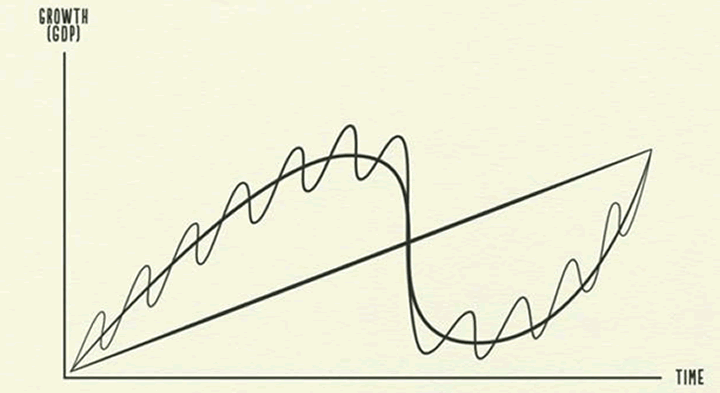By: GoldSilverWorlds
| Today’s market situation shows similarities with the reflationary periods of 1897 to 1914 and 1933 to 1939. As we all know, they ended in inflation and war. We are currently in a highly deflationary environment, and the banks are fighting this by pumping up trillions of liquidity in the system, hoping for a sustainable recover. At the same time, however, strongly opposing forces are at play destabilizing the whole globe (think of the Middle East, Africa, Ukraine). Given this evolution, and given that history rhymes, what can we expect going forward? Claudio Grass, managing director of Global Gold in Switzerland, sound money and monetary history specialist, discusses his view on the ongoing trend based on history with Casey Research (source). After 2008, the central banks tried to counter deflation by printing huge amounts of money. But the velocity of money, which is the credit in the system, is 30% down compared to 2008. It means that all the newly created “money” has not gone in the real economy. Most of the money has gone in the stock market, real estate market and government bonds. This could go on for a while. The outcomes, however, are limited. Deflation is one of them, but central banks will do whatever they can to avoid that. On the other hand, we can see hyperinflation, or a deflationary collapse, which both have the same outcome at the end of the day. This view is confirmed by Ray Dalio, who is the initiator of the following chart. If his expectations are correct, the chart suggests that we are about to experience a huge deleveraging, or, in other words, a long-term debt cycle fueled by the easy money of the past.
The chart could suggest that it represents a natural cycle, but one should not forget that these cycles are mostly artificial, as they are created by central banks and banking industry. So the cycle is rather created by mankind. The government debt bubble cannot be solved in a natural way, which leaves the option that debts will be wiped out. The gigantic artificial liquidity is simply not going to create wealth. If it were that easy to create wealth out of nothing, we could hand over every person $1,000,000 on a monthly basis (we all know this is not working). Currently, the system is going through a destabilization which coincides with the fight between the West and East. Meantime, most gold has moved from the West to the East for the last 14 or 20 years, which marks the shift of wealth from East to West. We now see the balance of power game, which is visible for instance in Ukraine. This is similar to the situation before WWI, when the British Empire followed the balance of power doctrine to Europe (they supported the second strongest in Europe to keep the balance of power). Likewise, the world experienced two huge reflationary periods, i.e. from 1897 till 1914, and 1933 till 1939 (before and after WWI). At the end of the day, most likely in the future it will be harsh. The question is: what will people make out of it? Will they understand that the actual system is not the one people should look for (that the government cannot protect them and that the government cannot give anything for free). Or will they chose for a system like the one in Switzerland, which still has a decentralized political system with a federalist structure, limiting the power of the government and politicians, coming much closer to a natural order than any other state on this planet? In this context, gold is and will be the canary in the coalmine. Rising gold prices reveal stress in the paper money system. The irony is that the paper price of gold suggests a bear market, while the physical market is very bullish. Since the price correction in April last year, the demand for physical gold tripled or quadrupled, depending on the area. 70% of all the gold refining goes through Switzerland. Claudio Grass confesses: “When I talk to the refineries here, their books are filled up until 2016. We definitely have to ask the question: if prices are based on supply and demand, why do we have such a low gold price versus a spiking physical gold demand?” Today’s artificial gold price is not sustainable longer term. The mining industry could reduce the capacity, some mines could even go bankrupt. That might result in a shortage if current gold owners do not sell their gold holdings and jewelry [which are being melted down for shipment to meet the demand in the East currently]. Claudio Grass believes that a loss of trust in paper money is brewing. Today’s circumstances already signal it, especially when looking at the geopolitical situations in North Africa, Asia and the borders of Europe (Ukraine). Participants are increasingly signaling a loss of trust in Western currencies, i.e. the dollar and the euro. With this de-stabilization the Western currency market becomes smaller. The financial system must come down (crash) before it can be rebuilt based on sound foundations. That will come with the crash of all paper currencies. In that transition period, gold will be the king, protecting the wealth and the hedge against the artificial wealth in the system. History has shown that debt defaults have occurred several times and the financial system has collapsed several times. In each instance, the only form of money that survived, was gold and silver. What the value would be is difficult to say. Besides, forget about dollars or euros, being paper currencies. That is not the correct measurement criteria. |

No comments:
Post a Comment